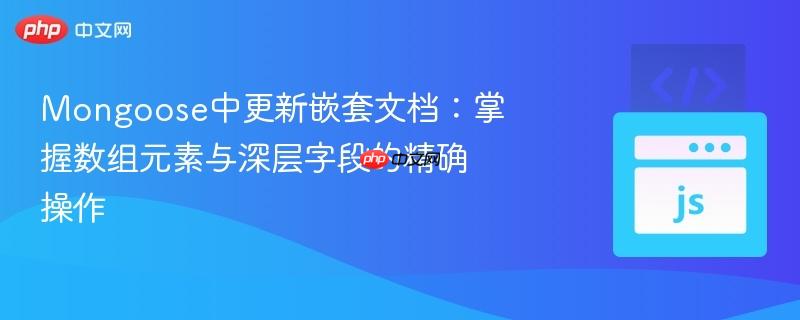
在mongoose中处理嵌套文档,尤其是当数据模型包含数组或深层对象时,更新特定字段可能会遇到挑战。许多开发者尝试使用javascript的数组访问语法来直接指定更新路径,但这种方法在mongodb的更新操作中是无效的。理解mongodb如何解析更新路径是解决此类问题的关键。
当我们的Mongoose模型中包含一个文档数组(例如,一个flashcardDeck包含一个flashcards数组,每个flashcard又包含side1和side2等字段)时,如果需要更新数组中某个特定索引处的元素的某个字段,直接使用类似flashcards[index].side1的JavaScript语法作为更新路径,会导致Mongoose或MongoDB无法识别,从而抛出错误。这是因为MongoDB的更新操作符(如$set)期望一个字符串形式的路径来定位要修改的字段,而不是一个可执行的JavaScript表达式。
例如,以下尝试更新flashcards数组中特定元素的side1字段的代码是错误的:
// 错误示例:直接使用JavaScript数组访问语法
flashcardDeck.updateOne(
{ _id: deck._id },
{ $set: { flashcards[Math.floor(i/2)].side1: newFlashcardsArr[i] } } // 语法错误
);上述代码中的flashcards[Math.floor(i/2)].side1并非一个有效的MongoDB字段路径字符串,而是JavaScript的语法,MongoDB无法直接解析。
解决这个问题的正确方法是利用MongoDB的“点表示法”(Dot Notation)。点表示法允许我们通过字符串路径来访问嵌套文档中的字段,包括数组中的特定元素。其基本格式是arrayName.index.fieldName。
为了动态地指定数组索引,我们首先计算出索引值,然后将其嵌入到点表示法的字符串路径中。
const idx = Math.floor(i/2); // 计算需要更新的数组索引
const updatePath = `flashcards.${idx}.side1`; // 构建点表示法路径
flashcardDeck.updateOne(
{ _id: deck._id },
{ $set: { [updatePath]: newFlashcardsArr[i] } } // 使用计算出的路径进行更新
);或者,更简洁地,直接在$set对象中使用模板字符串:
const idx = Math.floor(i/2); // 计算需要更新的数组索引
flashcardDeck.updateOne(
{ _id: deck._id },
{ $set: { [`flashcards.${idx}.side1`]: newFlashcardsArr[i] } }
);在这个示例中:
让我们通过一个更完整的例子来理解这个过程。假设我们有一个FlashcardDeck模型:
const mongoose = require('mongoose');
// 定义嵌套的 Flashcard Schema
const FlashcardSchema = new mongoose.Schema({
side1: { type: String, required: true },
side2: { type: String, required: true },
});
// 定义 FlashcardDeck Schema,其中包含一个 Flashcard 数组
const FlashcardDeckSchema = new mongoose.Schema({
name: { type: String, required: true },
flashcards: [FlashcardSchema], // 嵌套的 Flashcard 文档数组
});
// 创建 FlashcardDeck 模型
const FlashcardDeck = mongoose.model('FlashcardDeck', FlashcardDeckSchema);
module.exports = FlashcardDeck;现在,假设我们有一个deckId,并且想要更新其flashcards数组中索引为0的卡片的side1内容:
const FlashcardDeck = require('./models/FlashcardDeck'); // 假设模型路径
async function updateSpecificFlashcard() {
const deckId = '65b1a0d3f2c5e7a9b8c7d6e5'; // 假设的牌组ID,请替换为实际ID
const targetIndex = 0; // 想要更新的卡片在数组中的索引
const newSide1Content = 'Updated Question Text'; // 新的 side1 内容
try {
const result = await FlashcardDeck.updateOne(
{ _id: deckId }, // 查询条件:根据牌组ID查找
{ $set: { [`flashcards.${targetIndex}.side1`]: newSide1Content } } // 更新操作:使用点表示法
);
if (result.matchedCount === 0) {
console.log('未找到匹配的牌组。');
} else if (result.modifiedCount === 0) {
console.log('牌组已找到,但指定卡片内容未发生变化(可能新值与旧值相同)。');
} else {
console.log(`成功更新牌组 ${deckId} 中索引 ${targetIndex} 的卡片 side1。`);
}
} catch (error) {
console.error('更新失败:', error);
} finally {
// 实际应用中可能需要关闭Mongoose连接
// mongoose.connection.close();
}
}
// 调用函数执行更新
// updateSpecificFlashcard();在Mongoose中更新嵌套文档,特别是数组中的特定元素,关键在于正确使用MongoDB的“点表示法”结合$set操作符。通过构建精确的字符串路径(如flashcards.0.side1),我们可以避免JavaScript语法错误,并确保对复杂数据结构进行高效、准确的修改。掌握这一技巧对于开发涉及复杂数据模型的Node.js应用程序至关重要。
以上就是Mongoose中更新嵌套文档:掌握数组元素与深层字段的精确操作的详细内容,更多请关注php中文网其它相关文章!

每个人都需要一台速度更快、更稳定的 PC。随着时间的推移,垃圾文件、旧注册表数据和不必要的后台进程会占用资源并降低性能。幸运的是,许多工具可以让 Windows 保持平稳运行。

Copyright 2014-2025 https://www.php.cn/ All Rights Reserved | php.cn | 湘ICP备2023035733号